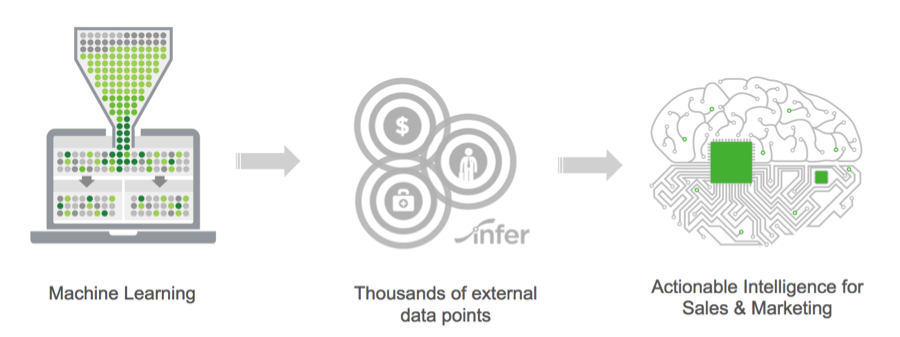
Even if you’re not the “early adopter” type, you’ve probably heard about the rise of predictive analytics for sales. Perhaps your marketing team has tried out HubSpot’s new predictive lead scoring capabilities and is recognizing the value this kind of data-driven insight can bring. If you’re wondering whether predictive intelligence could make your sales team’s job easier as well, the answer is a resounding yes.
Predictive technology has matured rapidly, and there’s now a whole community of forward-looking businesses that are already showing proven results. Rather than rely on human intuition to guess who your best leads are, why not use advanced predictive scoring models that take into account thousands of signals and employ sophisticated data science to compute accurate predictions?

Here are five ways smart sales teams should leverage this technology to double down on the most promising opportunities in their funnel:
1) Employ intelligent lead routing
It’s time for sales managers to stop routing leads based on relatively arbitrary attributes like geography or industry alone. Instead, with predictive scoring, you can evenly disperse high-potential accounts (whether inbound or outbound) across your top performing reps. This is a great way to avoid inadvertently overloading sales development reps or account executives with more good leads than they can reasonably handle. Our customer, Social Tables reinvented its definition of MQLs and started filtering anything below leads rated an “A” or “B” out of its sales queue -- and this more focused approach resulted in a $500,000/month increase in their pipeline.
Another approach we’ve seen is giving the lowest-scored leads to your newest reps. This minimizes the risk that you’ll lose key deals while untrained reps are coming up to speed, and it takes the pressure off them while they’re still practicing the pitch. For example, you can try a tiered training program, in which new reps spend some time working D-rated leads (those that aren’t a great fit for your product), then some time working C-rated leads, and eventually graduate to “B” leads. Once they show mastery by hitting the team’s average conversion rate, you can start feeding them their share of your hottest leads.
2) Refresh your sales SLAs
The problem with the guess-and-check approach of traditional SLAs is that they often focuses on one data point (like lead type) rather than leveraging all of the prospect information available. Just because someone signs up for your free trial doesn’t mean they are a good fit to buy your product. On the other hand, when you remix your SLAs to leverage predictive scores, you can align your team’s effort with a lead’s true likelihood of conversion.
At Infer, our inbound lead management SLA requires SDRs to follow up with inbound “A” and “B” leads within five minutes. Our “C” and “D” leads go directly to the marketing team, who put them in an appropriate nurture campaign until they show more interest. This approach allows us to minimize our response time and increase the number of meetings we book, as opposed to wasting time calling companies that are unlikely to make a purchase.
3) Narrow your outbound focus
Predictive can also play a big role when you’re expanding into new markets or segments. With outbound prospecting, it’s even more critical to focus on the right target accounts as opposed to trying to boil the ocean. No rep enjoys slugging through a purchased list with thousands of bad leads, just hoping to hit the jackpot with one good prospect.
Armed with a simple predictive score for each account, you can pinpoint a stack-ranked list of your top prospects. Don’t get hung up on the size of your list -- outbound is all about big deals, and predictive analytics can show the value of an account (i.e. its anticipated deal size, revenue impact and other metrics) before your team engages. With this quality over quantity approach, you’ll have confidence they’re spending their time in the right places. For the best targets, you might use sales acceleration software to trigger alerts or tasks that prioritize high-touch outreach. For others, it’s often better to pass them to marketers, who can first warm them up with account-based marketing programs prior to having your reps reach out.
4) Tailor personalized conversation points
It’s no secret that customizing prospecting messages can make a big difference. But most reps are missing out on a chance to go deeper with their emails and sales calls. By understanding key attributes for each account -- such as their business model, what technologies they use, etc. -- you can determine which pain points they likely have that your product can alleviate.
New tools can uncover this insight automatically, as an alternative to manual research. Some predictive solutions now push at-a-glance sales intelligence right into your CRM interface so that you can easily check out important prospect characteristics, like technographics. This allows your team to pre-plan meaningful conversation points that communicate a clear value proposition.
5) Ensure no lead is left behind
Last but not least, you should use predictive scores to prioritize “old” prospects and avoid missing out on any big opportunities. There’s always potential revenue stuck in your pipeline with leads who never responded to your initial outreach, as well as buyers who postponed their decision or chose a competitor (but might make a switch down the road). Most reps are so focused on hitting their immediate number that they forget nurturing isn’t just the job of marketing. Lighting up inactive accounts is a great way for sales to uncover hidden gold in the funnel.
When you see good, but older, leads owned by quota-carrying AEs (perhaps because they built strong relationships with champions during the sales cycle), you need to remind them to follow up more aggressively, or consider sending some back to SDRs who have more time for outreach. One approach is to carve off a couple nurture-specific SDRs and develop new scripts for them that go beyond the standard pitch for fresh prospects. That way, they won’t be distracted by their natural recency bias, and you can set quotas aligned with realistic conversion rates.
All of these predictive techniques greatly ease the grunt work of sales without risking pipeline opportunities. You can gain major lifts in win rates and conversions by prioritizing your flow of leads. Honing in on the most valuable prospects will accelerate the process of finding qualified leads, help you figure out where to focus your team’s energy, and give you a leg up on your competition. So, instead of looking in the rearview mirror and waiting to see which leads convert, put your resources where you’ve got the best shot at winning.



![10 Important Sales Analysis Reports [+ 4 Sales Report Templates]](https://knowledge.hubspot.com/hubfs/Sales-Analysis-Reports-1-20241007-6831164.webp)




